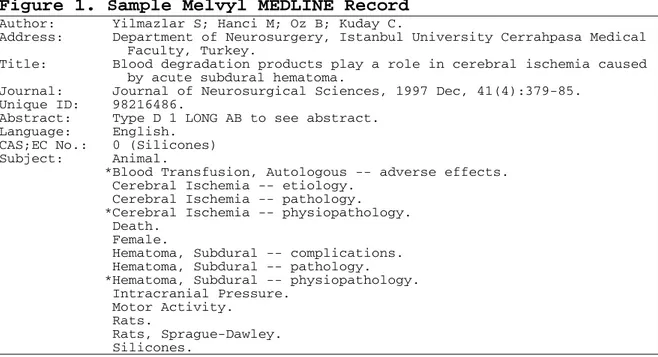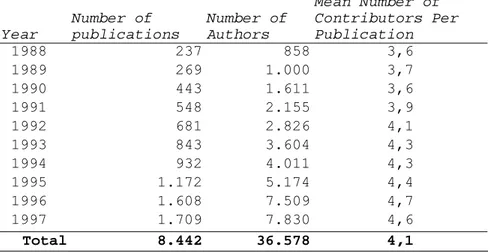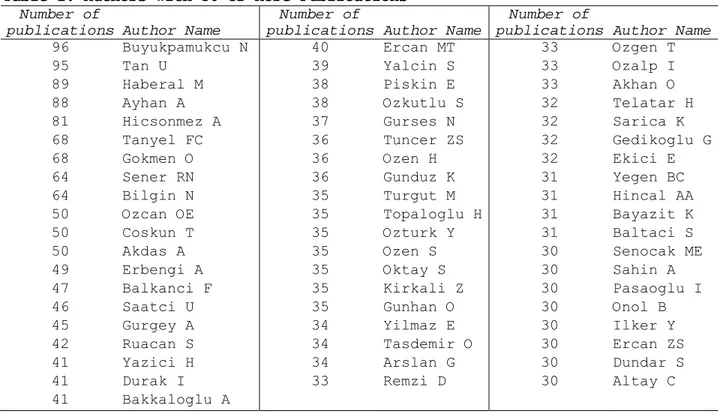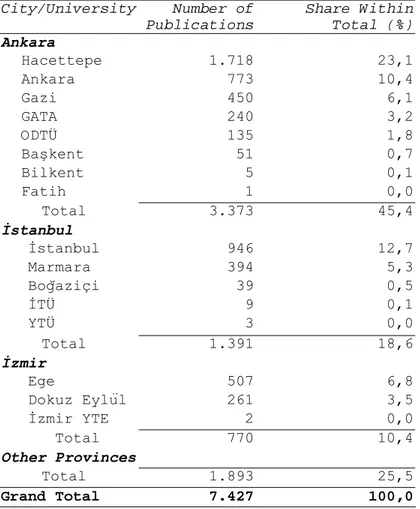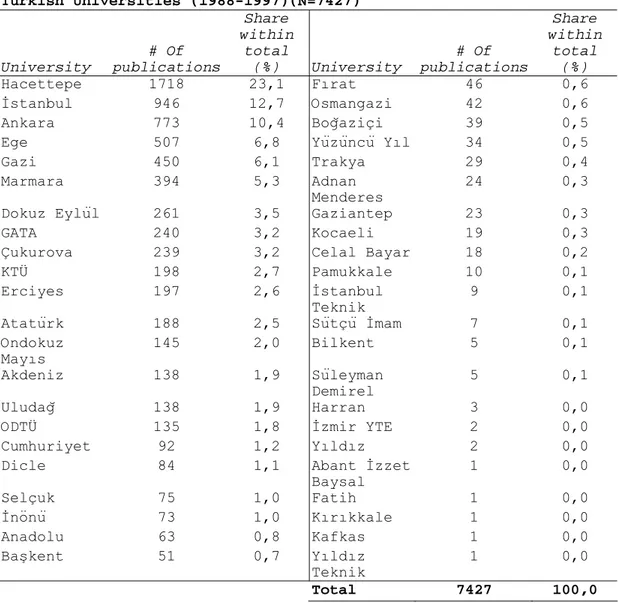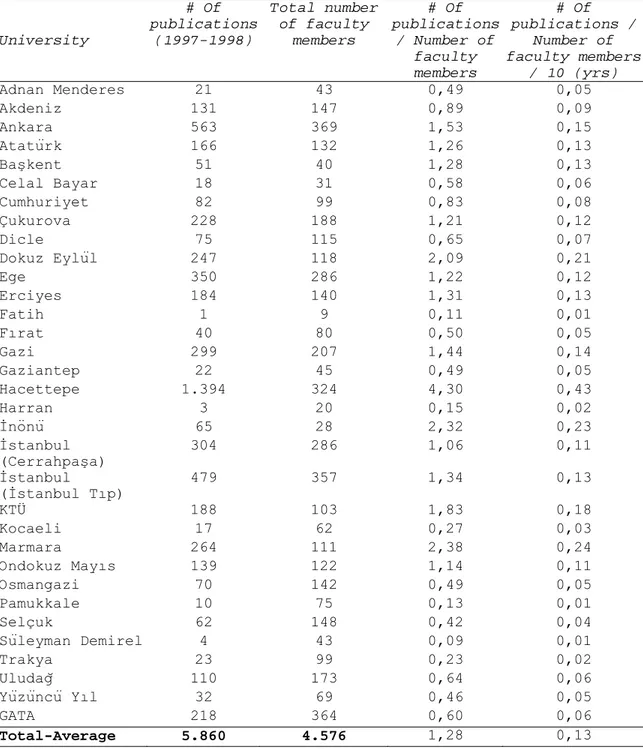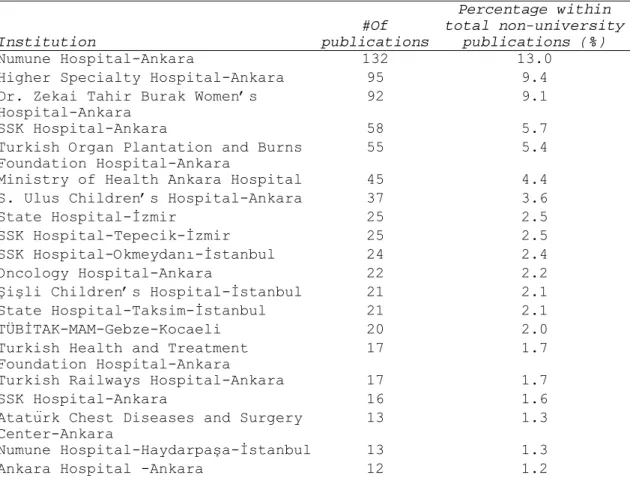Contribution of Turkish Researchers to the World’s Biomedical
Literature (1988-1997)
*Yaşar Tonta
Hacettepe University, Department of Library Science, 06532 Beytepe, Ankara (Turkey)
The contribution of Turkish researchers to positive sciences is increasing. Turkish scientists published more than 5.100 articles in 1998 in scientific journals indexed by the Institute for Scientific Information’s Science Citation Index, which elevated Turkey to the 25th place in the world rankings in terms of total
contribution to science. In this paper, we report the preliminary findings of the bibliometric characteristics (authors and affiliations, medical journals and their impact factors, among others) of a total of 8.842 articles published between 1988 and 1997 by scientists affiliated with Turkish institutions and indexed in MEDLINE, a well-known biomedical bibliographic database.
Introduction
Currently, there are some 40,000 scientific journals published regularly throughout the world. More than one million articles appear in those journals every year. The number of scientific publications is continually increasing due to the rapid developments in science and technology. Scientists specializing in certain fields ought to follow, scan and read increasingly large numbers of publications. In 1840s, German scientists protested the sheer number of medical journals published then, complaining that they were unable to keep up with 13 journals!1 Compare this with 4300 biomedical journals indexed in MEDLINE Plus database of the National Library of Medicine (NLM). The MEDLINE Plus database contains more than 11 million bibliographic citations.** Full texts of articles of some 400 medical journals are accessible through the Internet. Some 200
* A slightly different version of this paper was delivered (in Turkish) at an international symposium organized by the Turkish Librarians’ Association on the occasion of its 50th anniversary and appeared in the proceedings.
** This figure comes from the web site of the National Library of Medicine of USA (http://www.nlm.nih.gov/medlineplus/medline.html).
medical journals are currently being published in Turkey.2 Articles appearing in those journals are selectively indexed in Türk Tıp Dizini (Turkish Medical Index).
The number of articles published in international journals and authored by scientists affiliated with Turkish research institutions have increased tremendously in recent years. The contribution of Turkish researchers to the world science has increased accordingly: Turkey ranked 34th in 1995 in the world in terms of its contribution to the world science, 29th in 1996, 27th in 1997, and 25th in 1998 (with more than 5100 articles.3 It is observed that the number of biomedical publications in Turkey is increasing faster than that of engineering and other non-medical fields.4 This increase might be one of the main causes of the steep rise in Turkey's ranking that we have been witnessing in recent years.
This paper is an attempt to analyze the bibliometric features (number of authors, authors' affiliations, journals, etc.) of 8,842 publications whose first authors are affiliated with a Turkish research institution. All articles were published between 1988-1997 and indexed in the MEDLINE database of the National Library of Medicine.
Data Gathering and Analysis
We used Melvyl, the online catalog of the University of California, to perform
comprehensive searches on MEDLINE. We identified all the articles whose first authors were affiliated with a Turkish institution and were published between 1988-1997 in journals that were indexed in MEDLINE. We issued the following Melvyl command on MEDLINE: “FIND ADDRESS TURK OR TURKEY OR TURKISH OR TURKIYE OR TURKYE OR TURKEI OR TURQUIE OR TURCHIA AND DATE (19XX)”. Using
Melvyl's "mail" command, we then had the detailed search results sent to our electronic mail address. Figure 1 shows the fields that each MEDLINE record contains.
Figure 1. Sample Melvyl MEDLINE Record
Author: Yilmazlar S; Hanci M; Oz B; Kuday C.
Address: Department of Neurosurgery, Istanbul University Cerrahpasa Medical Faculty, Turkey.
Title: Blood degradation products play a role in cerebral ischemia caused by acute subdural hematoma.
Journal: Journal of Neurosurgical Sciences, 1997 Dec, 41(4):379-85. Unique ID: 98216486.
Abstract: Type D 1 LONG AB to see abstract. Language: English.
CAS;EC No.: 0 (Silicones) Subject: Animal.
*Blood Transfusion, Autologous -- adverse effects. Cerebral Ischemia -- etiology.
Cerebral Ischemia -- pathology. *Cerebral Ischemia -- physiopathology. Death.
Female.
Hematoma, Subdural -- complications. Hematoma, Subdural -- pathology. *Hematoma, Subdural -- physiopathology. Intracranial Pressure.
Motor Activity. Rats.
Rats, Sprague-Dawley. Silicones.
We created raw text files for each year's worth of data by combining files that were sent, due to their large sizes, separately to our address. We then ran one of the Unix text processing programs (awk) on those files to extract the needed fields.5 Thus we created separate files for 10 years' worth of data for authors, addresses, subjects, journals, language, type of contribution, and MeSH (Medical Subject Headings). We used a commercial spreadsheet program to analyze data. We removed all the white spaces between author names, addresses, and journal names for sorting purposes. Through an awk program, we found out the number of publications that each author contributed to both as the first and joint author, and the number of articles with Turkish affiliations that appeared in each journal. We sorted the results separately by author name, by the number
of publications per author, by journal name, and by the number of publications per journal. We used a commercial spreadsheet package to calculate means and standard deviations, and create related graphics.
Limitations of the Study
We used the term "publication" in this study so as to encompass all types of
contributions (e.g., original and review articles, notes, book reviews, letters to the editor and editorials) in biomedical journals that were indexed in MEDLINE. The analysis covers a total of 8.842 publications that appeared in international biomedical journals and were indexed in MEDLINE. Publications whose first authors not based in Turkey were not included in this study, as MEDLINE does not list the addresses of joint authors. In other words, contributions of Turkish researchers as joint authors (but not first authors) were excluded. Hence, it can be safely assumed that the number of publications Turkish researchers contributed to (either as first or joint authors) is much higher than what we report here. In addition, contributions of Turkish authors published in biomedical journals that are not indexed in MEDLINE are not included, either. Of 8.842 publications, a few may have foreign researchers listed as first authors as they were based in Turkey as visiting scholars at the time of writing up their contributions. Needles to say, some of the publications that we analyzed in this study list foreign researchers as joint authors.
Findings
As we indicated earlier, the total number of biomedical publications which Turkish researchers contributed to as first authors was 8,842. The distribution of those
publications is given in Fig. 2. As Fig. 2 shows, the number of publications has shown more than a seven-fold growth over the years, thereby increasing from 237 in 1988 to 1709 in 1997. This growth parallels with Turkey’s overall contribution to the world science (ranked 25th in 1998).
An overwhelming majority (98.7%) of 8.842 publications were written in English. The numbers of publications written in French and German were 53 (0.6%) and 36 (0.4%), respectively. Publications written in languages other than English, French and German were only 11.
Table 1 lists the figures for the numbers of publications and authors per year, and the mean number of authors per publication. The mean number of contributors to a
biomedical publication was 4.1. This figure has increased from 3.6 in 1988 to 4.6 in 1997 (Fig. 3).
Table 1. Numbers of Publications and Contributors,
And Mean Number of Contributors Per Publication (1988-1997)
Year Number of publications Number of Authors Mean Number of Contributors Per Publication 1988 237 858 3,6 1989 269 1.000 3,7 1990 443 1.611 3,6 1991 548 2.155 3,9 1992 681 2.826 4,1 1993 843 3.604 4,3 1994 932 4.011 4,3 1995 1.172 5.174 4,4 1996 1.608 7.509 4,7 1997 1.709 7.830 4,6 Total 8.442 36.578 4,1
The distribution of publications per number of contributors is given in Fig. 4. A total of 1.759 publications had four contributors, 1.648 had five, and 1.473 had three. Three-, four-, and five-author publications constituted 60% of all publications.
Table 2 lists the names and numbers of publications for authors who contributed to 30 or more publications over the ten-year period. Figures represent the contributions of researchers as both first and joint authors.
Table 2. Authors with 30 or More Publications
Number of
publications Author Name
Number of
publications Author Name
Number of
publications Author Name
96 Buyukpamukcu N 40 Ercan MT 33 Ozgen T
95 Tan U 39 Yalcin S 33 Ozalp I
89 Haberal M 38 Piskin E 33 Akhan O
88 Ayhan A 38 Ozkutlu S 32 Telatar H
81 Hicsonmez A 37 Gurses N 32 Sarica K
68 Tanyel FC 36 Tuncer ZS 32 Gedikoglu G
68 Gokmen O 36 Ozen H 32 Ekici E
64 Sener RN 36 Gunduz K 31 Yegen BC
64 Bilgin N 35 Turgut M 31 Hincal AA
50 Ozcan OE 35 Topaloglu H 31 Bayazit K
50 Coskun T 35 Ozturk Y 31 Baltaci S
50 Akdas A 35 Ozen S 30 Senocak ME
49 Erbengi A 35 Oktay S 30 Sahin A
47 Balkanci F 35 Kirkali Z 30 Pasaoglu I
46 Saatci U 35 Gunhan O 30 Onol B
45 Gurgey A 34 Yilmaz E 30 Ilker Y
42 Ruacan S 34 Tasdemir O 30 Ercan ZS
41 Yazici H 34 Arslan G 30 Dundar S
41 Durak I 33 Remzi D 30 Altay C
41 Bakkaloglu A
The first authors of a total of 7.427 publications (88%) are affiliated with Turkish universities. Figure 5 and Table 3 show the distribution of publications whose authors come from universities based in the largest three cities of Turkey, namely İstanbul, Ankara, and İzmir. Researchers based in Ankara universities contributed to, as first authors, a total of 3.373 publications, constituting the 45.4% of all publications generated
by academia. Researchers at İstanbul and İzmir universities follow those of Ankara with 1.391 (18.6%) and 770 (10.4%) publications, respectively.
Table 3. Number of Publications Generated by
Researchers Based in the Three Largest Cities in Turkey
City/University Number of Publications Share Within Total (%) Ankara Hacettepe 1.718 23,1 Ankara 773 10,4 Gazi 450 6,1 GATA 240 3,2 ODTÜ 135 1,8 Başkent 51 0,7 Bilkent 5 0,1 Fatih 1 0,0 Total 3.373 45,4 İstanbul İstanbul 946 12,7 Marmara 394 5,3 Boğaziçi 39 0,5 İTÜ 9 0,1 YTÜ 3 0,0 Total 1.391 18,6 İzmir Ege 507 6,8 Dokuz Eylül 261 3,5 İzmir YTE 2 0,0 Total 770 10,4 Other Provinces Total 1.893 25,5 Grand Total 7.427 100,0
Table 4 lists the number of biomedical publications produced by all universities along with the Gülhane Military Medical Academy between 1988-1997. Hacettepe University in Ankara ranks first with 1.713 publications and produces almost one-fourth (23.1%) of all biomedical publications. İstanbul University follows Hacettepe with 946 publications (12.7% of all publications) along with Ankara and Aegean Universities (773 and 507 publications, respectively). In other words, more than half (53%)of all biomedical
publications were produced by the abovementioned four universities. Based on Science
Citation Index data for the years 1981 through 1993, Onat and Yazıcı found that the
weight of the Hacettepe, İstanbul, Cerrahpaşa (İstanbul) and Ankara medical schools in terms of number of publications within the total has decreased from 84% to 45%. The finding we obtained in this study with regards to the productivity of those four medical schools (46%) is similar to that of Onat and Yazıcı.6
Table 4. Number of Biomedical Publications of Turkish Universities (1988-1997)(N=7427) University # Of publications Share within total (%) University # Of publications Share within total (%) Hacettepe 1718 23,1 Fırat 46 0,6 İstanbul 946 12,7 Osmangazi 42 0,6 Ankara 773 10,4 Boğaziçi 39 0,5
Ege 507 6,8 Yüzüncü Yıl 34 0,5
Gazi 450 6,1 Trakya 29 0,4
Marmara 394 5,3 Adnan
Menderes 24 0,3
Dokuz Eylül 261 3,5 Gaziantep 23 0,3
GATA 240 3,2 Kocaeli 19 0,3
Çukurova 239 3,2 Celal Bayar 18 0,2
KTÜ 198 2,7 Pamukkale 10 0,1 Erciyes 197 2,6 İstanbul Teknik 9 0,1 Atatürk 188 2,5 Sütçü İmam 7 0,1 Ondokuz Mayıs 145 2,0 Bilkent 5 0,1 Akdeniz 138 1,9 Süleyman Demirel 5 0,1 Uludağ 138 1,9 Harran 3 0,0
ODTÜ 135 1,8 İzmir YTE 2 0,0
Cumhuriyet 92 1,2 Yıldız 2 0,0
Dicle 84 1,1 Abant İzzet
Baysal 1 0,0 Selçuk 75 1,0 Fatih 1 0,0 İnönü 73 1,0 Kırıkkale 1 0,0 Anadolu 63 0,8 Kafkas 1 0,0 Başkent 51 0,7 Yıldız Teknik 1 0,0 Total 7427 100,0
Table 5 gives the number of publications produced by Turkish medical schools (excluding pharmacy, dentistry, nursing, and others), total number of faculty members (professors, associate and assistant professors) and their average annual and five-year productivity levels. Among the medical schools, Hacettepe ranks first in terms of both the total number of publications (1394) and the productivity level (0,43 publications per year) (Fig. 6). Hacettepe Medical School produces almost one-fourth of all the publications produced by the Turkish medical schools. Yurtsever points out the possibility that such evaluations may either meaninglessly penalize or promote medical schools with fewer faculty members.7
Table 5. Total Number of Publications, Total Number of Faculty Members, and Number of Publications Per Faculty Member in Turkish Medical Schools
University # Of publications (1997-1998) Total number of faculty members # Of publications / Number of faculty members # Of publications / Number of faculty members / 10 (yrs) Adnan Menderes 21 43 0,49 0,05 Akdeniz 131 147 0,89 0,09 Ankara 563 369 1,53 0,15 Atatürk 166 132 1,26 0,13 Başkent 51 40 1,28 0,13 Celal Bayar 18 31 0,58 0,06 Cumhuriyet 82 99 0,83 0,08 Çukurova 228 188 1,21 0,12 Dicle 75 115 0,65 0,07 Dokuz Eylül 247 118 2,09 0,21 Ege 350 286 1,22 0,12 Erciyes 184 140 1,31 0,13 Fatih 1 9 0,11 0,01 Fırat 40 80 0,50 0,05 Gazi 299 207 1,44 0,14 Gaziantep 22 45 0,49 0,05 Hacettepe 1.394 324 4,30 0,43 Harran 3 20 0,15 0,02 İnönü 65 28 2,32 0,23 İstanbul (Cerrahpaşa) 304 286 1,06 0,11 İstanbul (İstanbul Tıp) 479 357 1,34 0,13 KTÜ 188 103 1,83 0,18 Kocaeli 17 62 0,27 0,03 Marmara 264 111 2,38 0,24 Ondokuz Mayıs 139 122 1,14 0,11 Osmangazi 70 142 0,49 0,05 Pamukkale 10 75 0,13 0,01 Selçuk 62 148 0,42 0,04 Süleyman Demirel 4 43 0,09 0,01 Trakya 23 99 0,23 0,02 Uludağ 110 173 0,64 0,06 Yüzüncü Yıl 32 69 0,46 0,05 GATA 218 364 0,60 0,06 Total-Average 5.860 4.576 1,28 0,13
Note: The figures for the number of faculty members were taken from Student Selection and Placement Center’s annual statistics for the 1996-1997 academic year.8 The number of publications per faculty member is likely to be lower than
what is reported here as medical schools hired relatively more faculty members in recent years. It should also be noted that some of the universities listed in the table were established after 1990s (i.e., Adnan Menderes, Celal Bayar, Harran, Kocaeli, Pamukkale and Süleyman Demirel universities were established in 1992; Başkent and Osmangazi in 1993; Fatih in 1994; and Yeditepe in 1996).9
Researchers based in 126 non-university establishments produced a total of 1015 publications (12% of the total number of publications). Table 6 lists the most prolific 20 institutions. Researchers at Ankara Numune Hospital ranked first among non-university institutions with a total of 132 publications. In other words, Ankara Numune Hospital researchers produced some 13% of the total number of publications outside academia. Researchers affiliated with Ankara Higher Specialty Hospital (95), Dr. Zekai Tahir Burak Women’s Hospital (92) and Ankara Social Security Institution Hospital (55) followed Ankara Numune Hospital. Researchers affiliated with the first five institutions listed in Table 6 produced some 43% of all non-university publications. The first ten institutions produced 58%, and the first 20 produced 75% of all non-university publications.
Table 6. The Most Prolific Non-University Institutions in Biomedicine (1988-1997) Institution #Of publications Percentage within total non-university publications (%) Numune Hospital-Ankara 132 13.0
Higher Specialty Hospital-Ankara 95 9.4
Dr. Zekai Tahir Burak Women’s
Hospital-Ankara 92 9.1
SSK Hospital-Ankara 58 5.7
Turkish Organ Plantation and Burns
Foundation Hospital-Ankara 55 5.4
Ministry of Health Ankara Hospital 45 4.4
S. Ulus Children’s Hospital-Ankara 37 3.6
State Hospital-İzmir 25 2.5
SSK Hospital-Tepecik-İzmir 25 2.5
SSK Hospital-Okmeydanı-İstanbul 24 2.4
Oncology Hospital-Ankara 22 2.2
Şişli Children’s Hospital-İstanbul 21 2.1
State Hospital-Taksim-İstanbul 21 2.1
TÜBİTAK-MAM-Gebze-Kocaeli 20 2.0 Turkish Health and Treatment
Foundation Hospital-Ankara 17 1.7
Turkish Railways Hospital-Ankara 17 1.7
SSK Hospital-Ankara 16 1.6
Atatürk Chest Diseases and Surgery
Center-Ankara 13 1.3
Numune Hospital-Haydarpaşa-İstanbul 13 1.3
Zeynep Kamil Women’s and Children’s
Hospital-İstanbul 12 1.2
Chest Surgery and Research
Center-Koşuyolu-İstanbul 11 1.1
Total 783 77.1
Other 232 22.9
Some 36 non-university institutions based in Ankara published 672 publications. This figure constitutes two thirds (66%) of all publications produced by institutions outside the academia. Those 39 non-academic institutions based in İstanbul produced a total of 192 publications, 19% of all publications generated by non-academic institutions. Almost 8% (78 publications) of all non-university contributions were produced by 12 institutions based in İzmir. In other words, 87 non-academic institutions based in Turkey’s three largest cities, namely, İstanbul, Ankara and İzmir, generated 942 publications, almost 93% of all university contributions. The rest (7% or 73 publications) of the non-university contributions were produced by some 39 non-academic institutions based in other cities.
Public institutions generated an overwhelming majority of non-university contributions. The contribution of the private hospitals, clinics, and professional associations constituted a mere 5% (51 publications) of all non-academic publications.
Contributions by Turkish researchers appeared in 1190 different biomedical journals. There were 19 journals publishing 50 or more contributions by Turkish researchers. Some 19% (1606 publications) of all contributions by Turkish researchers appeared in those 19 journals. The names and the 1996 impact factors of 19 journals with 50 or more
contributions are given in Table 7.10
Table 7. Journals Publishing 50 or More Contributions by Turkish Researchers. Journal Impact factor (1996) # Of contributions by Turkish researchers
International Urology and Nephrology - 234
Turkish Journal of Pediatrics 0,130 120
British Journal of Urology 1,005 114
International Journal of
Neuroscience - 107
Journal of Pediatric Surgery 1,062 97
Acta Paediatrica Japonica 0,049 83
Neurosurgical Review 0,200 77
Acta Neurochirurgica 0,498 72
General Pharmacology 0,818 72
Clinical Nuclear Medicine 0,437 64
International Journal of Gynaecology
And Obstetrics 0,387 64
Japanese Heart Journal 0,186 64
European Urology 0,981 62
Pediatric Radiology 0,489 59
Journal of Marmara University
Dental Faculty - 57
European Journal of Pediatric
Surgery 0,326 56
Angiology 0,448 53
European Journal of Obstetrics
Gynecology and Reproductive Biology 0,537 51
Total 1606 (19%)
Other journals 6836 (81%)
Grand Total 8.442
Conclusion
We summarized the preliminary findings of our research that was based on 8.442 biomedical publications that were contributed to by Turkish researchers and appeared in MEDLINE between 1988-1997. A more detailed evaluation of our findings is planned. We believe that we can gain a better understanding about the contributions of Turkish researchers to the world’s biomedical literature.
Here are some of the research questions that we plan to answer in the second phase of this research: the distributions of contributions by type (i.e., original articles, book
reviews, letters to editor, etc.) and by sub fields within biomedicine; contributions of various departments (medicine, pharmacy, dentistry, nursing, etc.) of universities and the number of publications per faculty member by universities; contributions of researchers
based in public hospitals and clinics; the relationship between impact factors of journals in which contributions of Turkish researchers appeared and citations to those
contributions; the availability of those journals in Turkish medical school libraries and its likely impact on collection development policies.
References
1. İ. Kum, “Türkiye’de Tıp Kütüphaneleri”. (Medical Libraries in Turkey)(Unpublished dissertation) Hacettepe University, Ankara, 1974, p. 41-43.
2. İ.H. Gökçora, “Welcome speech” in: Symposium: Scientific Writing, Editing and
Auditing in Medicine. November 18, 1994, TÜBİTAK, Ankara. (13-14). The Scientific
and Technical Research Council of Turkey, Health Sciences Research Group, Ankara, 1996, pp. 13-14, p. 13.
3. M. İlhan, Bilimsel yayında Türkiye yükselmeyi sürdürüyor. (Turkey’s rise continuing in scientific publications)Cumhuriyet Bilim Teknik No. 631 (April 24, 1999), p. 2. 4. A. Onat, H. Yazıcı, “Current status of scientific medical publications in Turkey” in:
Symposium: Scientific Writing, Editing and Auditing in Medicine. November 18, 1994, TÜBİTAK Ankara. (39-46). The Scientific and Technical Research Council of Turkey,
Health Sciences Research Group, Ankara, 1996, pp. 39-46, p. 41.
5. A. Aho, B.W. Kernighan, P.J. Weinberger, The AWK Programming Language. Addison Wesley, Reading, M.A., 1988.
7. E. Yurtsever, “Yayın sayılarındaki artışlar üzerine” (On the increase of the number of
publications) Cumhuriyet Bilim Teknik No. 629 (April 10, 1999), pp. 20-21, p.20. 8. 1997 öğretim yılı yükseköğretim istatistikleri (Higher education statistics of
1996-1997 academic year). Student Selection and Placement Center, Ankara, 1996-1997, Table 24.
9. Yükseköğretim Kurulu Başkanlığı, Türk yükseköğretiminin bugünkü durumu (The state-of-the-art of Turkish higher education), Higher Education Council, Ankara, p. 5-6.
10. Institute for Scientific Information, 1996 Science Citation Index Journal Citation
